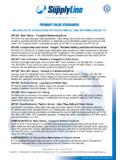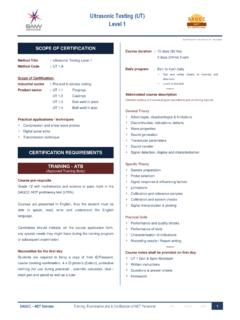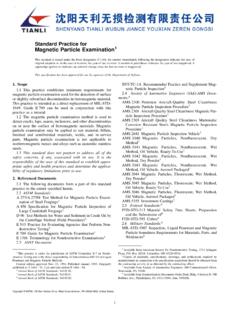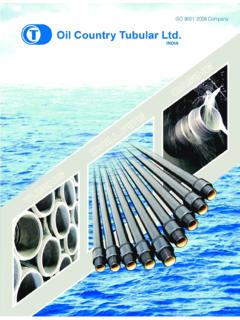Transcription of 1 Scope 2 Normative references
1 Non- destructive testing of steel forgings- part 1: Magnetic particle inspection (BS EN 10228-1:1999). 1 Scope This part of EN 10228 describes the method and acceptance criteria to be used for the magnetic particle inspection of forgings manufactured from ferromagnetic materials. The method described is used for the detection of surface discontinuities. It can also detect discontinuities just below the surface but sensitivity to such discontinuities diminishes rapidly with depth. 2 Normative references This part of EN 10228 incorporates, by dated or undated reference , provisions from other publications. These Normative references are cited at the appropriate places in the text and the publications are listed hereafter. For dated references , subsequent amendments to or revisions of any of these publications apply to this part of EN.
2 10228 only when incorporated in it by amendment or revision. For undated references the latest edition of the publication referred to applies. EN 473, Qualification and certification of NDT personnel General principles. prEN ISO 9934-1, Non- destructive testing Magnetic particle testing part 1: General principle. (ISO/DIS 9934-1:1996). prEN ISO 9934-2, Non- destructive testing Magnetic particle testing part 2: Characterization of products. (ISO/WD 9934-2). prEN ISO 9934-3, Non- destructive testing Magnetic particle testing part 3: Equipment. (ISO/DIS 9934-3:1998). 3 Items for agreement The following aspects concerning magnetic particle inspection shall be agreed between the purchaser and the supplier at the time of enquiry and order: a) the manufacturing stages(s) at which magnetic particle inspection is to be performed (see clause 8).
3 B) the surface areas to be examined (see clause 9);. c) the quality class required, or the quality classes and the surface areas to which they apply (see clauses 9, 10 and 15);. d) whether the inspection shall be performed with non-fluorescent inks or fluorescent inks or powders (see );. e) whether a particular current waveform is required (see );. f) the applicable recording and acceptance criteria if different from those detailed in Table 2. g) whether demagnetization is to be carried out after the inspection, together with the maximum level of residual magnetism (see clause 17);. h) whether the inspection is to be conducted in the presence of the purchaser or his representative;. i) whether the written procedure shall be submitted for approval by the purchaser (see clause 5).
4 4 Written procedure General Magnetic particle inspection shall be performed in accordance with a written procedure. Where specified in the enquiry or order, the written procedure shall be submitted to the purchaser for approval prior to the examination. Description This written procedure shall be one of the following: a) a product specification;. b) a procedure written specifically for the application;. c) this part of EN 10228 may be used if it is accompanied by examination details specific to the application. Content The procedure shall contain the following details as a minimum requirement: a) description of the forgings to be inspected;. b) reference documents;. c) qualification and certification of inspection personnel;. d) stage of manufacture at which the inspection is carried out.
5 E) surface areas specified in terms of the applicable quality classes;. f) magnetizing technique(s);. g) description of inspection equipment;. h) calibration and checking of equipment;. i) waveform and flux density and/or tangential field strength required for each technique used;. j) detection media, and contrast paint if used;. k) surface condition;. l) viewing conditions;. m) method of marking or recording indications;. n) whether demagnetization is required; if so the method to be used and required maximum level of residual magnetism;. o) acceptance criteria;. p) examination report. 5 Personnel qualification Personnel shall be qualified and certificated in accordance with EN 473. 6 testing system Magnetizing equipment If the contact current flow (prods) magnetization method is used on a finished machined surface, then the prod contact points shall be checked after magnetization for damage, using an alternative magnetization technique, penetrant testing or visual examination.
6 All equipment shall be calibrated and checked in accordance with prEN ISO 9934-3. One or more of the following types of magnetizing equipment shall be used: a) alternating current electromagnetic yokes (see annex A);. b) current flow equipment with prods (see annex A);. c) permanent magnets;. d) magnetic flow equipment with flexible cable or coil;. e) central conductor;. f) magnetic induction;. g) equipment enabling multiple magnetizing techniques, either coincidentally or in sequence. Detection media Detection media shall conform to the requirements detailed in prEN ISO 9934-2. Function checks A function check shall be carried out prior to the inspection to ensure the proper functioning of the inspection system. The check shall be performed as detailed in prEN ISO 9934-1.
7 NOTE The temperature of the forging should be checked to ensure that it is within the detection media manufacturer's specified temperature limits. 7 Stage of manufacture Where practicable, final acceptance inspection shall be performed on the forging in its delivery condition (see clause 4). 8 Surface condition General Surfaces to be examined shall be clean and free from scale, oil, grease, machining marks, heavy paint and any other foreign matter that could adversely affect inspection sensitivity or the interpretation of indications. Cleaning and preparation of the surfaces shall not be detrimental to the material, the surface finish or the detection media. Surface condition related to quality class The finish of surfaces to be examined shall conform to the requirements detailed in Table 1 for the applicable quality class.
8 Table 1 - Surface condition Surface finish Quality classes1). 1 2 3 4. 6,3 mm<Ra 12,5 mm X X. Ra 6,3 mm X X X2) X3). 1) X signifies the quality class that can be achieved for the specified surface finish. 2) Quality class not applicable to the examination of surfaces with a machining allowance greater than 3. mm per face. 3) Quality class not applicable to the examination of surfaces with a machining allowance greater than 1. mm per face. Ra = arithmetical mean deviation of the profile. As-forged surface condition It is difficult to carry out a comprehensive examination on a forged surface. The surface to be inspected shall be prepared by shot-blasting, sand-blasting or surface grinding so that defects can be clearly distinguished from indications resulting from surface irregularities.
9 For general applications quality classes 1 and 2 shall be applicable. For closed die forgings quality class 3 shall be the minimum requirement. 9 Coverage Where practical, inspection shall be performed such that 100 % coverage of the surface under examination is achieved. Viewing of the area under examination shall be completed before proceeding to the next area or the next stage of magnetization. 10 Magnetization Direction of magnetization Magnetization shall be performed in accordance with the requirements detailed in prEN ISO 9934-1. The surface shall be examined in at least two approximately perpendicular directions to detect defects lying in any orientation. NOTE 1 Where the probable nature and orientation of flaws in a forging can be forecast with confidence as, for example, in certain long forged parts, and where specified in the enquiry or order, magnetization may be performed in a single direction.
10 NOTE 2 Where magnetization is performed by locally applying the current flow method or using the magnetic flow method with a portable electromagnetic yoke, it is recommended that the surface under examination should be marked in a grid to ensure 100 % coverage. The recommended size of the grid and magnetizing directions are detailed in annex A. Current waveform The supplier shall decide which waveform to use unless a specific current waveform ( alternating current or half-wave rectified alternating current) has been agreed between the purchaser and supplier. NOTE reference should be made to prEN ISO 9934-1 for guidance. Flux density and field strength The tangential flux density shall be at least 1,0 T. The adequacy of the flux density and/or field strength shall be verified on the surface under examination, in each magnetizing direction, prior to or during the examination, using one or more of the methods detailed in prEN ISO 9934-3.









